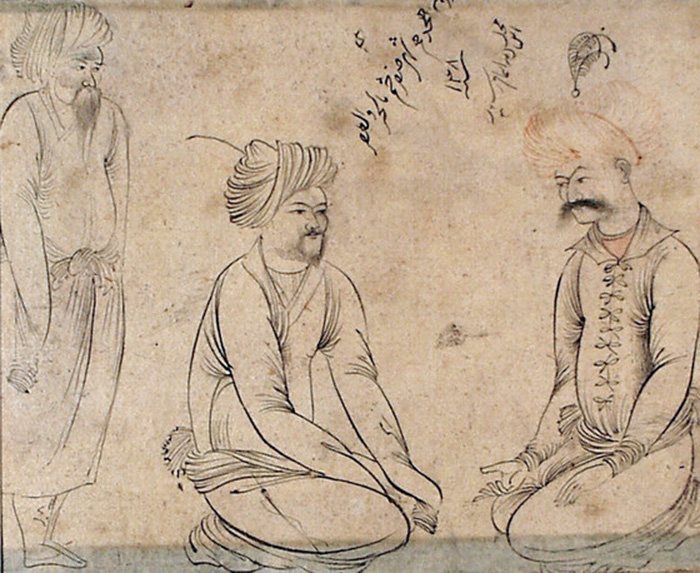Moʿin Moṣavver | Individual Drawings and Paintings
Drawing 1638.4
Shah ʿAbbās I (probably) Meeting with an Uzbeg
Location: Los Angeles County Museum of Art, M.73.5.469, the Nasli Heeramoneck Collection, gift of Joan Palevsky.
Pen and ink drawing with gold and color washes on paper. (W x H) 10.2 x 8.7 cm.
Signature: Unsigned but dated 1[0]48/1638.
Inscription
Diagonally at the top: . . . ruz-e . . . [panj šan]ba hejdahom-e šahr-e ṣafar ḥatm bālḥer va alẓafar sana 1[0]48 in majles (?) ba etmām rasid.
Translation: “This group was completed on Thursday the eighteenth of the month of Ṣafar in the year 1[0]48 / 1 July 1638.” The beginning of the inscription has been trimmed in mounting, with the resulting loss of at least one word. In all probability the inscription originally read panj šanba (Thursday), not simply šanba (Saturday) as presently. The inscription is not signed.
Description:
Three figures are represented. Kneeling at the right is the main personage, alternatively identified as Shah Shah ʿAbbās I, or his successor Shah Ṣafi I. He is portrayed in his late thirties, with a broad black mustache, turban, and a long robe with long sleeves and an open collar. The shah looks intently toward the left at another dignitary seated facing him, near the center of the composition, with whom he is engaged in conversation. This dignitary is perhaps an Uzbeg; he wears a turban with a conical kolāh, and a long robe with a sash, and sports a neatly trimmed beard and mustache; his hands are withdrawn inside his sleeves leaving the empty cuffs dangling from his lap. A guard, or servant, drawn in lighter lines, stands erectly on the far left. Portrayed with a long beard and wrinkled brow, the attendant is clad similarly to the center figure, and repeats the gesture of withdrawing his hands inside his sleeves.
Bibliography:
Pal, LA_1973, pp.136-37, no.239.
Commentary:
The depiction of the shah is identical to his portrayal on the previous miniature (no. 1638.3), which is dated only one day earlier. Please refer to 1638.3 for additional comments which equally apply to this miniature. The style appears to be that of Moʿin Moṣavver, and the inscription, although unsigned, could be Moʿin’s hand. Altogether, an attribution to Mo¯in appears plausible, and there seems to be no reason to dispute the date of 1638 recorded on the miniature.
Photo courtesy of The Los Angeles County Museum of Art, The Nasli M. Heeramaneck Collection, gift of Joan Palevsky. Copyright © Los Angeles County Museum of Art.
Robert Eng
Last Updated: February 20, 2018 | Originally published: February 20, 2018
Drawing 1638.4
Shah ʿAbbās I (probably) Meeting with an Uzbeg
Location: Los Angeles County Museum of Art, M.73.5.469, the Nasli Heeramoneck Collection, gift of Joan Palevsky.
Pen and ink drawing with gold and color washes on paper. (W x H) 10.2 x 8.7 cm.
Signature: Unsigned but dated 1[0]48/1638.
Inscription
Diagonally at the top: . . . ruz-e . . . [panj šan]ba hejdahom-e šahr-e ṣafar ḥatm bālḥer va alẓafar sana 1[0]48 in majles (?) ba etmām rasid.
Translation: “This group was completed on Thursday the eighteenth of the month of Ṣafar in the year 1[0]48 / 1 July 1638.” The beginning of the inscription has been trimmed in mounting, with the resulting loss of at least one word. In all probability the inscription originally read panj šanba (Thursday), not simply šanba (Saturday) as presently. The inscription is not signed.
Description:
Three figures are represented. Kneeling at the right is the main personage, alternatively identified as Shah Shah ʿAbbās I, or his successor Shah Ṣafi I. He is portrayed in his late thirties, with a broad black mustache, turban, and a long robe with long sleeves and an open collar. The shah looks intently toward the left at another dignitary seated facing him, near the center of the composition, with whom he is engaged in conversation. This dignitary is perhaps an Uzbeg; he wears a turban with a conical kolāh, and a long robe with a sash, and sports a neatly trimmed beard and mustache; his hands are withdrawn inside his sleeves leaving the empty cuffs dangling from his lap. A guard, or servant, drawn in lighter lines, stands erectly on the far left. Portrayed with a long beard and wrinkled brow, the attendant is clad similarly to the center figure, and repeats the gesture of withdrawing his hands inside his sleeves.
Bibliography:
Pal, LA_1973, pp.136-37, no.239.
Commentary:
The depiction of the shah is identical to his portrayal on the previous miniature (no. 1638.3), which is dated only one day earlier. Please refer to 1638.3 for additional comments which equally apply to this miniature. The style appears to be that of Moʿin Moṣavver, and the inscription, although unsigned, could be Moʿin’s hand. Altogether, an attribution to Mo¯in appears plausible, and there seems to be no reason to dispute the date of 1638 recorded on the miniature.
Photo courtesy of The Los Angeles County Museum of Art, The Nasli M. Heeramaneck Collection, gift of Joan Palevsky. Copyright © Los Angeles County Museum of Art.
Robert Eng
Last Updated: February 20, 2018 | Originally published: February 20, 2018
